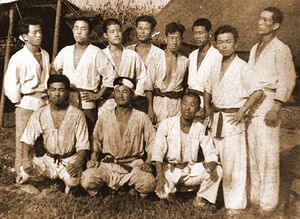No edit summary |
(Adding categories) |
||
| (2 intermediate revisions by the same user not shown) | |||
| Line 1: | Line 1: | ||
[[File:ByungInYoon.jpg|thumb|right|300px|Yoon, Byung-in (kneeling, center) with students during special weekend training session (ca. 1947).]] |
[[File:ByungInYoon.jpg|thumb|right|300px|Yoon, Byung-in (kneeling, center) with students during special weekend training session (ca. 1947).]] |
||
| − | '''YOON, Byung-in''' |
+ | '''YOON, Byung-in''' (May 18, 1920 – April 3, 1983) was the founder of ''YMCA Kwon Bop Bu'' the school that eventually became [[Chang Moo Kwan]]. |
Yoon was born in Mu-sun, Bong-Chon, Manchhuria. Yoon's family fled to Manchuria during the Japanese occupation of Korea. Yoon studied Chinese Chuan Fa under the guidance of a Mongolian instructor in Manchuria. Later, Yoon trained Karate at the Nihon university karate club in Japan with Kanken Tōyama. |
Yoon was born in Mu-sun, Bong-Chon, Manchhuria. Yoon's family fled to Manchuria during the Japanese occupation of Korea. Yoon studied Chinese Chuan Fa under the guidance of a Mongolian instructor in Manchuria. Later, Yoon trained Karate at the Nihon university karate club in Japan with Kanken Tōyama. |
||
| Line 17: | Line 17: | ||
{{Wikipedia}} |
{{Wikipedia}} |
||
[[Category:Person]] |
[[Category:Person]] |
||
| + | [[Category:Taekwondo Hall of Fame]] |
||
| + | [[Category:Pioneer]] |
||
Latest revision as of 16:23, 26 January 2018

Yoon, Byung-in (kneeling, center) with students during special weekend training session (ca. 1947).
YOON, Byung-in (May 18, 1920 – April 3, 1983) was the founder of YMCA Kwon Bop Bu the school that eventually became Chang Moo Kwan.
Yoon was born in Mu-sun, Bong-Chon, Manchhuria. Yoon's family fled to Manchuria during the Japanese occupation of Korea. Yoon studied Chinese Chuan Fa under the guidance of a Mongolian instructor in Manchuria. Later, Yoon trained Karate at the Nihon university karate club in Japan with Kanken Tōyama.
Yoon was not initially engaged in karate training at the university, but was often seen practicing conditioning exercises against a courtyard tree. This tree reportedly started leaning from his practice. Japanese karate students pursued a Korean karate student that skipped karate class to spend time with his sweetheart. After being persuaded by the beat-up student to help, Yoon sprung into action using Chuan Fa. He skillfully deflected and evaded the karate students’ strikes and kicks to the point that they gave up and ran back to tell their teacher about what happened. Teacher Kanken Tōyama invited Yoon Byung-in to tell him about the skillful non-karate martial art he used against his students. Yoon explained to Toyama about his Chuan-fa education in Manchuria. Toyama appreciated the Chuan-fa background since he (Toyama) had studied Chuan-fa in Taiwan for 7 years, previously. They decided to exchange knowledge; Yoon Byung-in would teach Toyama Kanken Chuan Fa and Toyama Kanken would teach Yoon Byung-in his Shudokan Ryu Karate.
Yoon later created his art and called it Kwon Bop Kong Soo Do. Unlike other taekwondo kwan (schools), early Chang Moo Kwan was mainly based on Chinese Chuan-fa (Chuan Fa) and Shotokan Karate. The early Chang Moo Kwan taught the forms Dan Kwon (short fist), Chang Kwon (Long Fist), Tai Jo Kwon (Fist of the Founding King), Pal Gi Kwon (Eighth Manchurian Cavalry), and Doju San (Escaping Mist). In addition, they practiced a staff form developed by Yoon Byung-in and a staff form developed by Yoon Byung-in's friend and Ji-do Kwan founder, "Yoon Ui-Byung (Yoon Kwe-byung)."
From 1951 to 1966, the whereabouts and activities of Yoon Byung-in are unknown, as he traveled to North Korea in August 1950 with his older brother, Yoon Byung-du, a Captain in the North Korean Army.
In 1966 and 1967, he taught Gyuck Sul "special combat strategy" to special forces of the Moran Bong. In late 1967, Master Yoon completed his assignment and returned to his supervisor position at a concrete factory in Cheong-Jin City, where he worked until his death from lung cancer in April 1983.
References[]
| This page uses Creative Commons Licensed content from Wikipedia (view authors). |